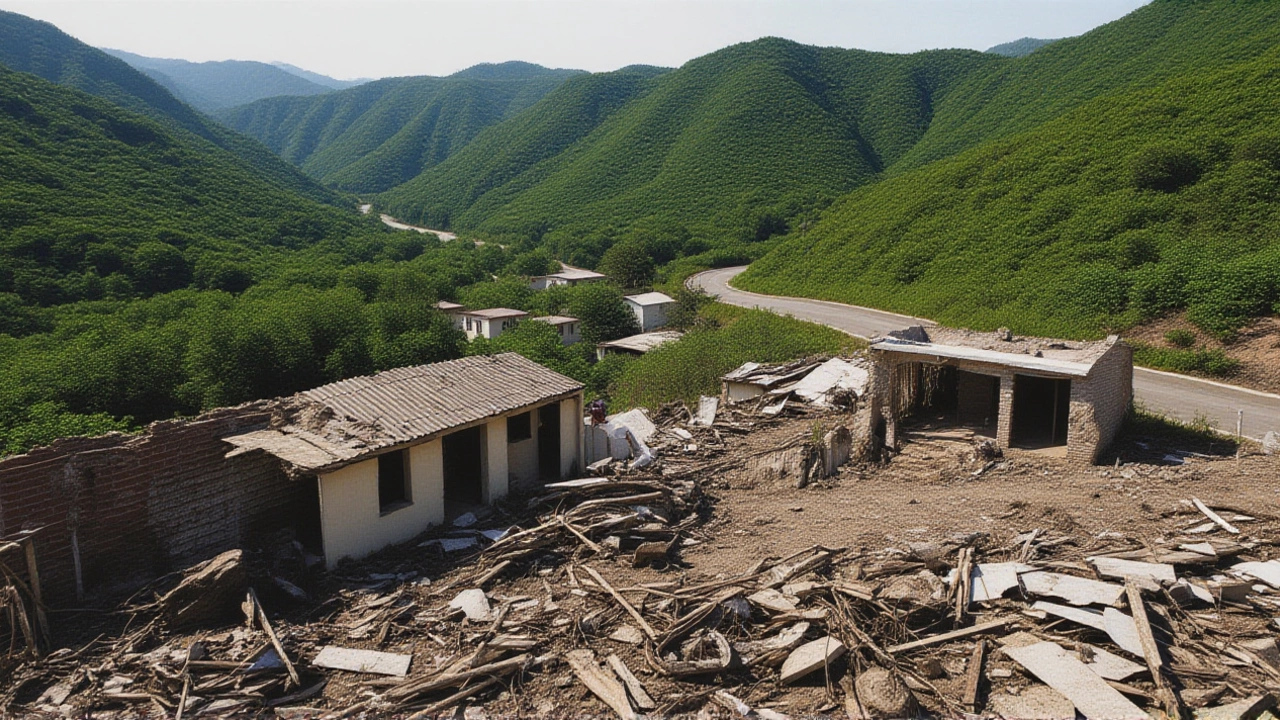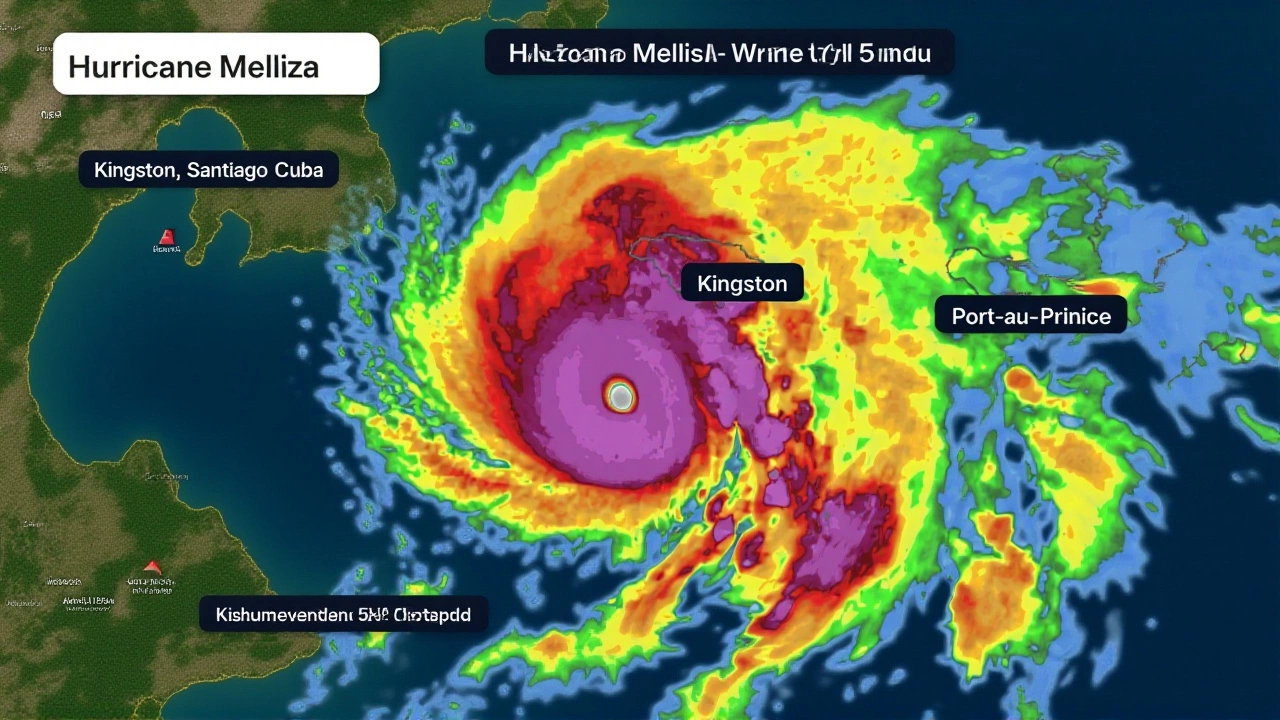When Hurricane Melissa made landfall on the night of Hurricane Melissa made landfall on the night of October 28, 2025, it didn’t just hit Jamaica—it shattered expectations. With sustained winds of 175 mph and a central pressure of just 912 millibars, the storm became the strongest Atlantic hurricane ever recorded in October since 2015. The National Hurricane Center broke its usual silence, using the phrase "total structural failure"—a term never before deployed in public advisories—to describe what was coming. This wasn’t just another storm. It was a catastrophe dressed in rain and wind, and Jamaica was directly in its path.
"Total Structural Failure": The NHC’s Unprecedented Warning
Matthew Cappucci, senior meteorologist at MyRadar Inc., flew into the eye of Hurricane Melissa aboard a NOAA Hurricane Hunter aircraft on the evening of October 27, 2025. What he saw confirmed the worst-case scenario: a compact, hyper-intense core with winds gusting over 200 mph. "It’s going to cause extreme destruction to the point the National Hurricane Center is using phrasing like total structural failure," Cappucci told anchor Geoff during a live broadcast at 11:42 PM EDT. "They tend to be pretty taciturn. When they break out phrasing like that, you know it’s the real deal."
The NHC’s language shift wasn’t arbitrary. Historical data shows that since 1980, only three Atlantic hurricanes have triggered such extreme terminology—Hurricane Andrew in 1992, Hurricane Michael in 2018, and Hurricane Ian in 2022. Each resulted in catastrophic, long-term infrastructure collapse. Melissa’s rapid intensification—from a tropical storm to Category 5 in under 24 hours—was fueled by unusually warm waters in the Jamaica Channel, hovering at 87°F. That’s 2.5 degrees above seasonal average. Climate scientists have flagged this as a troubling new normal.
Jamaica’s Emergency Response: 802 Shelters, 11 Airports Closed
By 8:00 AM EST on October 28, the Jamaican Ministry of National Security, under Minister Horace Chang, activated Phase 3 of the National Disaster Preparedness Plan. All 14 parishes—from Kingston and St. Andrew to remote St. Thomas—were under mandatory evacuation orders. The government opened 802 emergency shelters across the island, many in schools and community centers reinforced to withstand 180 mph winds. Around 2.8 million people, nearly 95% of Jamaica’s population, were in the storm’s direct path. An estimated 400,000 lived in high-risk flood zones, particularly along the north coast where storm surge could reach 20 feet.
All 11 commercial airports, including Sangster International Airport in Montego Bay and Norman Manley International Airport in Kingston, shut down at 3:00 PM EST. The United States Agency for International Development (USAID) had prepositioned 20,000 emergency relief kits at Manley Airport just two days earlier—water purification tablets, hygiene kits, and emergency blankets—ready for immediate distribution. Those supplies are now sitting in locked hangars, waiting for the skies to clear.
Regional Fallout: Haiti, Dominican Republic Bear the First Blow
Even before landfall, Melissa’s outer bands had already turned parts of the Caribbean into rivers. In Haiti, the Civil Protection Directorate (DPC), led by Director Jerry Chandler, confirmed three flood-related deaths in the Sud-Est department on October 27. In the Dominican Republic, the Emergency Operations Center (COE), under General Juan Manuel Méndez García, reported 18,000 displaced persons across 13 provinces. Entire neighborhoods in Pedernales and Barahona were submerged. Rescue teams waded through waist-deep water, pulling families from rooftops.
These weren’t just tragedies—they were warnings. Haiti, still reeling from political chaos and the 2021 earthquake, has no functioning early warning system. The Dominican Republic’s infrastructure, while stronger, was overwhelmed. Both nations now face a secondary crisis: contaminated water and disease outbreaks. The Caribbean Disaster Emergency Management Agency (CDEMA), headquartered in Bridgetown, Barbados, activated its Regional Response Mechanism at 10:00 AM EDT on October 28, deploying 12 urban search-and-rescue teams from Antigua and Barbuda, The Bahamas, and Trinidad and Tobago. They’re on standby, ready to fly into Jamaica the moment the winds drop.

What Comes Next: Cuba, the Caribbean, and the Climate Question
By 8:00 AM EDT on October 29, 2025, Hurricane Melissa is forecast to weaken to Category 3 strength—still dangerous, with 115 mph winds—as it approaches eastern Cuba. The island’s government has already begun evacuating coastal communities in Guantánamo and Holguín. But the bigger concern is what happens after. If Melissa lingers over Cuba’s mountainous terrain, it could reorganize and regain strength as it re-emerges into the Gulf of Mexico. That’s a nightmare scenario for Florida and the Gulf Coast, still recovering from Hurricane Idalia in 2023.
And then there’s the climate question. The 2025 Atlantic hurricane season, which began June 1 and runs through November 30, has already produced eight named storms—the highest number through October since 2020. Sea surface temperatures in the Caribbean have been above average for 14 consecutive months. The World Meteorological Organization (WMO) has quietly revised its seasonal forecast upward, now predicting 20 named storms this year, with 9 expected to become hurricanes. Scientists say we’re no longer just seeing stronger storms—we’re seeing them form faster, linger longer, and strike with more precision.
Why This Matters Beyond Jamaica
Jamaica isn’t just a tourist destination. It’s a critical economic hub for the Eastern Caribbean. Its ports handle over $2 billion in annual trade. Its power grid, already fragile, could be offline for months. The World Bank estimates recovery could cost upwards of $3.2 billion—nearly 20% of Jamaica’s GDP. Insurance companies are bracing for claims that could rival those from Hurricane Maria in 2017.
But beyond economics, this storm exposes a deeper truth: small island nations are on the front lines of a climate crisis they didn’t create. They have no carbon emissions to speak of, yet they bear the brunt of storms made worse by emissions from distant continents. The world watches as Jamaica braces. But will it act?
Frequently Asked Questions
How does this compare to Hurricane Gilbert in 1988?
Hurricane Gilbert, a Category 5 storm that struck Jamaica in September 1988, caused 433 deaths across the Caribbean and remains the most destructive hurricane in the region’s modern history. While Melissa is stronger in wind speed (175 mph vs. Gilbert’s 185 mph), Gilbert was larger and slower-moving, leading to more prolonged flooding. Melissa’s compact size means more concentrated wind damage, but less rainfall overall—though its rapid intensification makes it harder to prepare for.
Why did the National Hurricane Center change its language?
The NHC reserves extreme language for storms that threaten near-total infrastructure collapse. "Total structural failure" has never been used before in a public advisory. This shift reflects growing scientific consensus that modern hurricanes, fueled by warmer oceans, are now capable of destroying even well-built structures. The change is meant to jolt complacent populations into action—especially in places like Jamaica, where many homes are still built to outdated codes.
What’s the timeline for recovery in Jamaica?
Initial recovery could take weeks—power lines are down across the island, and major roads are blocked by debris and landslides. Full restoration of electricity and clean water may take 6 to 12 months. The Jamaican government has requested international aid through CDEMA and the UN. USAID and the Red Cross are preparing to deploy mobile water units and temporary power generators once access is secured.
Is Cuba at risk of a direct hit?
Cuba is not expected to take a direct hit, but the eastern provinces—particularly Guantánamo and Holguín—will face Category 3 conditions with winds over 115 mph, torrential rain, and storm surge up to 12 feet. Cuban authorities have already evacuated 120,000 people from coastal areas. The island’s stronger infrastructure and experience with hurricanes may limit casualties, but agricultural losses could be severe, especially in tobacco and sugar crops.
What role did MyRadar Inc. play in this forecast?
MyRadar Inc., based in Santa Barbara, California, provided real-time radar and satellite data used by the NHC and emergency managers. Their meteorologist Matthew Cappucci’s firsthand observations from the NOAA Hurricane Hunter flight gave critical ground-truth data that confirmed the storm’s intensity beyond what satellites could measure. This collaboration between private tech firms and federal agencies is becoming vital as storms intensify faster than traditional models can track.
Are future hurricanes going to be even worse?
Yes. Climate models project that by 2040, Category 4 and 5 hurricanes will be 50% more frequent in the Atlantic, with intensification speeds doubling. The 2025 season is a preview: warmer waters, lower wind shear, and higher humidity are creating perfect conditions for rapid intensification. Without global emissions cuts, storms like Melissa won’t be anomalies—they’ll be the new normal.





